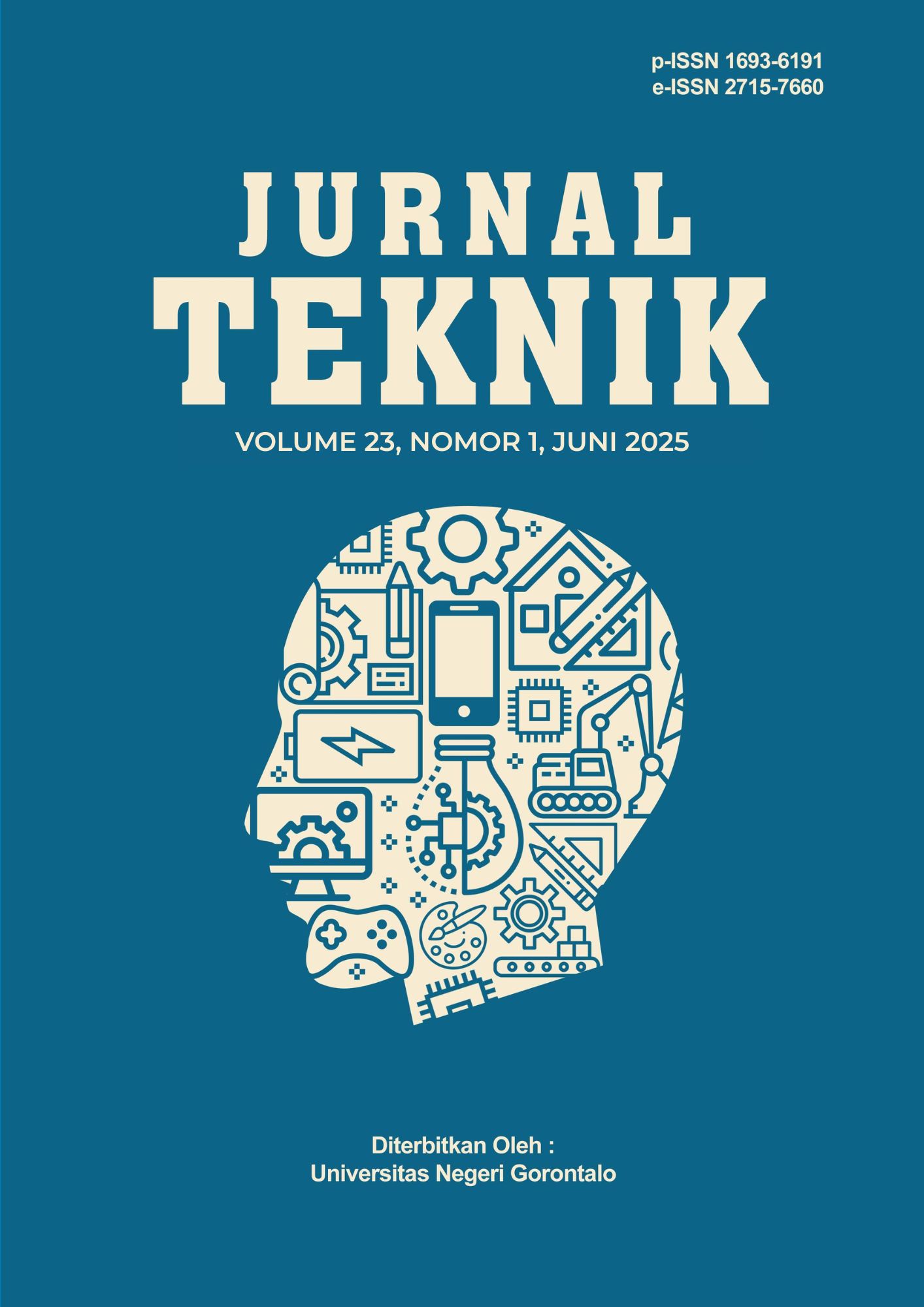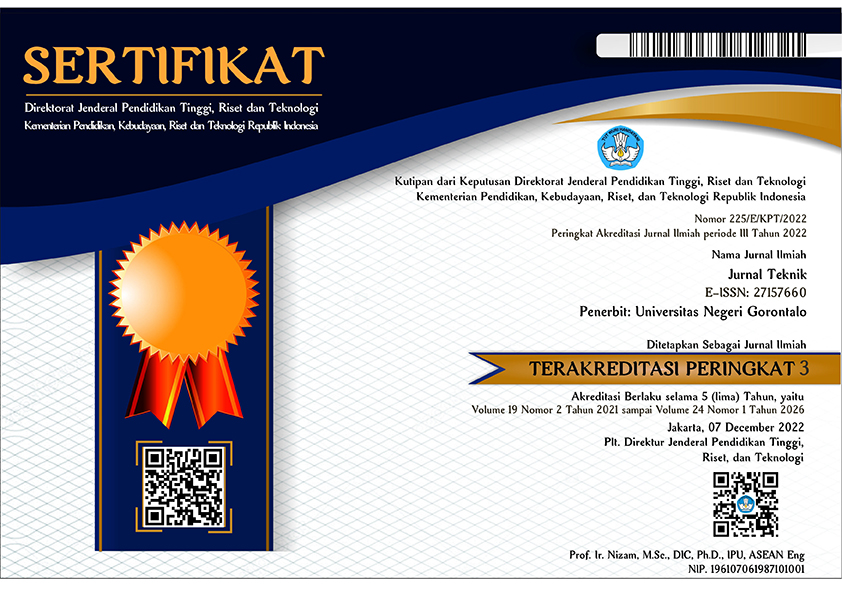Pengaruh Desain Cerobong Boiler Terhadap Sebaran Emisi Partikulat Menggunakan Perangkat Pemodelan Aermod
Abstract
Particulate emissions from boiler activities are known has a negative impact on health, such as causing respiratory problems. The particulate emission dispersion model generated from the chimney of a boiler can be known using the aermod modeling tool, through this model, the concentration of particulate emissions received by the environment around the activity can be studied. The design of the boiler chimney is also known to affect the concentration of particulate matter that is dispersed. This study aims to determine the effect of chimney design on the distribution of particulate emissions from boilers activities. The particulate dispersion model was carried out using the aermod modeling tool with several fixed variables, namely climatic conditions, the location of chimney and reseptor, and particulate emissions coming out from boiler, while the independent variables were variations in chimney diameter and heights. The results of particulate distribution model show that chimneys with a diameter of 2 meters and a height of 28 meters have a wider distribution of 93.96 meters from the emission source with a maximum concentration of 29.41 µm/Nm3. While the lowest concentration received by the receptor of 2.51 µm/Nm3 came from the chimney with a larger diameter and higher chimney.
Downloads
References
Aggarwal, A., & Haritash, A. K. (2018). Air Pollution Modelling-A Review AIR POLLUTION MODELLING – A REVIEW. International Journal of Advanced Technology in Engineering and Science, 2(6), 355–364.
Anaam A. Sabri. (2011). Mathematical Model for the Study Effects of Meteorological
Conditions on Dispersion of Pollutants in Air. Diyala Journal of Engineering Sciences, 4(2), 150–165. https://doi.org/10.24237/djes.2011.04212
Cimorelli, A. J., Perry, S. G., Venkatram, A., Weil, J. C., Paine, R. J., Wilson, R. B., Lee,
R. F., Peters, W. D., & Brode, R. W. (2005). AERMOD: A dispersion model for industrial source applications. Part I: General model formulation and boundary layer characterization. Journal of Applied Meteorology, 44(5), 682–693. https://doi.org/10.1175/JAM2227.1
Firstanti, A. A., Afiuddin, A. E., & Ramadani, T. A. (2022). Pola Sebaran Emisi SO 2 , NO 2 , dan Partikulat dari Cerobong Batu Bara Industri Kecap Menggunakan Software Screen View. 5(2623), 78–82.
Gibson, M. D., Kundu, S., & Satish, M. (2013). Dispersion model evaluation of PM2.5, NOX and SO2 from point and major line sources in Nova Scotia, Canada using AERMOD Gaussian plume air dispersion model. Atmospheric Pollution Research, 4(2), 157–167. https://doi.org/10.5094/APR.2013.016
Hadlocon, L. S., Zhao, L. Y., Bohrer, G., Kenny, W., Garrity, S. R., Wang, J., Wyslouzil, B., & Upadhyay, J. (2015). Modeling of particulate matter dispersion from a poultry facility using AERMOD. Journal of the Air and Waste Management Association, 65(2), 206–217. https://doi.org/10.1080/10962247.2014.986306
Matacchiera, F., Manes, C., Beaven, R. P., Rees-White, T. C., Boano, F., Mønster, J., & Scheutz, C. (2019). AERMOD as a Gaussian dispersion model for planning tracer gas dispersion tests for landfill methane emission quantification. Waste Management, 87, 924–936. https://doi.org/10.1016/j.wasman.2018.02.007
Ilaboya, I. R., Atikpo, E., Umukoro, L., Omofuma, F. E., & Ezugwu, M. O. (2011). Analysis of the Effects of Mixing Height and Other Associated Factors on the Effective Dispersion of Plume. Iranica Journal of Energy & Environment, 2(2), 153–160.
Keputusan Kepala Bapedal No. 205 Tahun 1996 Tentang : Pedoman Teknis
Pengendalian Pencemaran Udara Sumber Tidak Bergerak, (1996).
Peraturan Menteri Lingkungan Hidup No 7 Tahun 2007 tentang Baku Mutu Emisi Sumber Tidak Bergerak Bagi Ketel Uap No Title, (2007).
Prabasari, I. G., & Pusparani, N. (2022). Model Persebaran Emisi pada Pembangkit Listrik Tenaga Uap Berbahan Bakar Serat dan Cangkang Kelapa Sawit Menggunakan Perangkat Pemodelan Aermod. Jurnal Daur Lingkungan, 5(2), 75. https://doi.org/10.33087/daurling.v5i2.158
Sharma, N., Chaudhry, K. K., & Chalapati Rao, C. V. (2005). Air pollution dispersion studies through environmental wind tunnel (EWT) investigations: A review. Journal of Scientific and Industrial Research, 64(8), 549–559.
Siriwardena M.B.D.K., S. N. T. S. (2020). Optimization of an Industrial Boiler Operation.
Journal of Research Technology and Engineering, 1(3), 126–134.
Suleman, N., & Paputungan, M. (2019). Esterifikasi dan Transesterifikasi Stearin Sawit untuk Pembuatan Biodiesel. 17(1), 66–77.
Sunaryanto, R. (2023). Pengaruh Emisi Cerobong Boiler Batubara Terhadap Udara Ambien. Jurnal Techlink, 1(01), 18–28. https://doi.org/10.59134/jtnk.v1i01.468
Tawil, E. (2016). Boiler Classification and Application Credit: 2 PDH. Continuing Education and Development, 877, 29.
Thad Godish. (2004). Air Quality (4th ed.). A CRC Press Company Boca Raton London. Xu, M., Azevedo, J. L. T., & Carvalho, M. G. (2000). Modelling of the combustion process and Nox emission in a utility boiler. Fuel, 79(13), 1611–1619. https://doi.org/10.1016/S0016-2361(00)00019
Copyright (c) 2025 Ira Prabasari, Winny Laura Christina Hutagalung, Fetty Febriasti Bahar, Dyah Kumalasari (Author)

This work is licensed under a Creative Commons Attribution-ShareAlike 4.0 International License.













